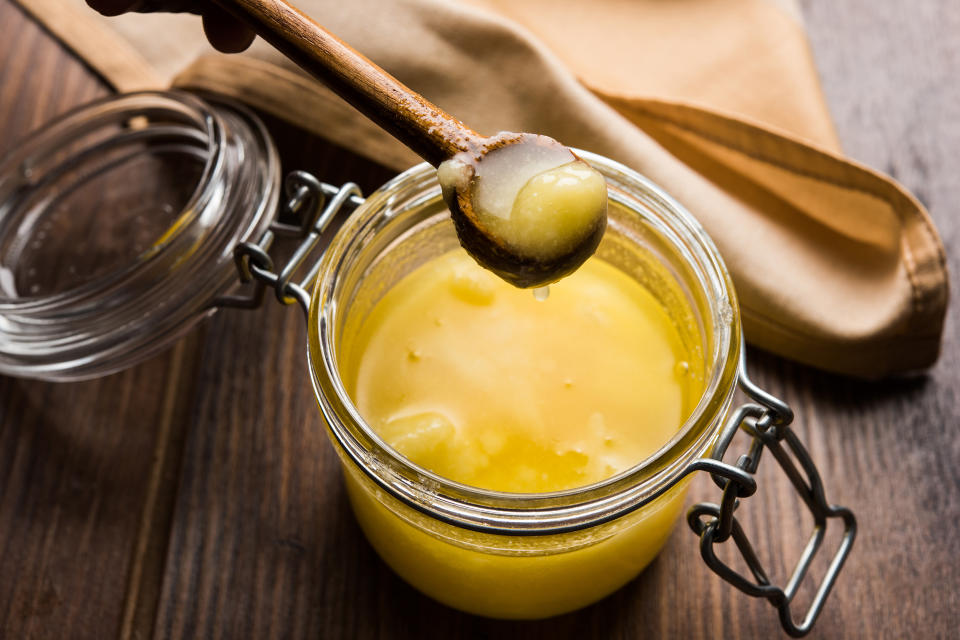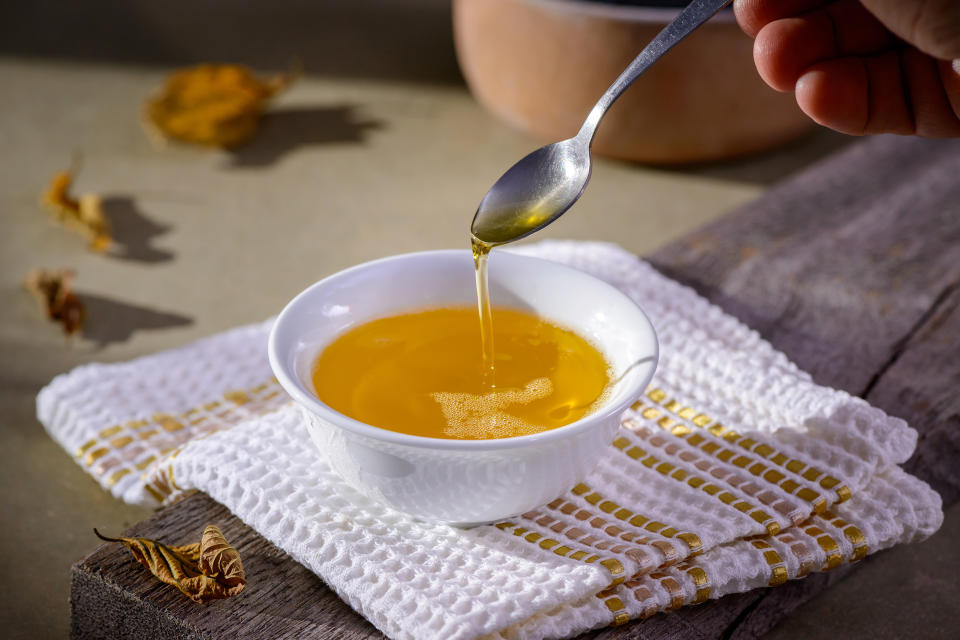Influencers are eating ghee by the spoonful. Brands are responding with whitewashed versions.
Watching ghee enter the mainstream has been a slow burn for many South Asians. Unlike viral foods that suddenly appear on everyone’s For You page with fadlike immediacy, the ancient, traditional form of clarified butter has been gradually making its way into the zeitgeist over the last two years.
In that time, South Asian food experts say, brands have taken notice. Influencers who tout it as the secret to their perfect skin or as an instant weight loss trick have shaped how some American consumers view ghee, which is made by heating milk solids until they separate from the liquid fat. New trendy companies have picked up on it and are producing whitewashed versions of it with exploitative names and logos, critics say, with the potential to take away space from South Asian-owned businesses.
The most watched TikTok on ghee features eccentric influencer Jeremy Fragrance, known for appraising smells and giving fragrance advice. He has made several videos simply sniffing jars of ghee while flapping his tongue and making noises at the camera.
“It is so sexy,” he said in the most viral of his ghee clips, which got 6.8 million views. “As far as I know, this originated in India because they didn’t have a fridge for a long time.”
He’s not technically wrong about that, according to experts, but the exoticization of ghee online has taken more insidious forms. The South Asian household staple is now blowing up on health TikTok.

From Trader Joes’ achaars to turmeric lattes to Alison Roman’s infamous chickpea stew, brown people on social media have spent years calling out brands, companies and chefs for similar treatment of other traditional foods.
Jeremy Fragrance did not respond to a request for comment.
Influencers have recorded themselves eating spoonfuls of ghee, posing with the product in stores and promoting it as a new find. In tandem, brands have released flavored ghees — with infusions ranging from garlic to Italian seasoning to vanilla bean. The jars of ghee that appear on your social media feeds are probably not South Asian-owned either. With lofty claims and unnecessary additives, food scientists say it’s the epitome of viral marketing.
And trendy brands capitalizing on online hype tend to overprice and underdeliver, crowding the space and making it harder for South Asian-owned shops to survive, food experts say. On top of that, many aren’t clear with their customer base on how exactly to use ghee.
“People go overboard in this quest for exotic foods, ‘superfoods,’” said Krishnendu Ray, a professor of Food Studies at New York University. “One day, it’s turmeric. Next day, it’s ghee. And the day after maybe it’s quinoa. It’s basically a marketing ploy. I don’t see anything redeeming about it.”
Ghee being co-opted with misleading marketing
Ghee is just the latest South Asian product to be co-opted and produced en masse in the U.S., but food experts say it’s far from the first. Previously hard to find outside of Indian grocery stores, it now lines shelves at big American chains.
Ancient Organics, a Northern California-based brand started by two white men, says on its website that it makes ghee according to traditional ayurvedic methods. It also features Sanskrit script on its jar packaging.
In a statement to NBC News, Ancient Organics’ representatives said Indian ayurveda practitioners were the inspiration behind their brand.
“Our intention is not to diminish a culture by celebrating and sharing it, we feel that through educating the Western market over the last 20 years we have actually made space for more ghee purveyors,” a representative for Ancient Organics told NBC News. “We believe that the rising tide lifts all boats.”
Similar ventures, like Iowa-based Spring Sunrise Natural Foods, also say vedic properties are used to make their ghee products, which range from $10 to $20 per jar. In contrast, a jar of ghee at Indian grocery store Patel Brothers is sold for as low as $5.49.
“The point of it is to make profit, and then you make whatever claims you need to make,” Ray said. “I’m totally skeptical of the gimmickry and the exoticism and the marketing of stuff that we probably don’t need.”
After NBC News reached out to Spring Sunrise for a statement, managing partner Donald Revolinski said they would be removing references to ayurveda from the brand’s marketing.
“At Spring Sunrise Natural Foods we value the tenets of ayurveda in our own lives. However, after researching this issue further, we acknowledge the problem of cultural appropriation and therefore have decided to remove references to ayurveda from our label and marketing,” he said. “We maintain the highest standards for our products.”
Some brands that have emerged in the last few years, like 4th and Heart, claim ghee can be a 1:1 substitute for other oils and it can promote weight loss. Food experts say that may not be entirely true, especially if it’s used in excess. While there are beneficial properties to any fat, Syracuse University professor Sudha Raj said that, like anything, it can be harmful if you don’t know how to use it.
“Today, if you tell people ghee is an excellent fat, you have to indicate to them that ghee should not be consumed in copious amounts,” said Raj, who specializes in nutrition and dietetics. “Anything when eaten in copious amounts can be problematic.”
On the subcontinent, ghee started as a rare, expensive commodity that was used little by little and stored for a long time.
“In India, because of the tropical weather, milk spoils very easily,” she said. “So fermentation is a process that originated in many countries because that was the only way of increasing the shelf life.”
4th and Heart did not respond to requests for comment.
The cultural significance of ghee
For Ray, the NYU professor, the smell of ghee elicits memories of life cycle rituals. It’s served at weddings, in religious ceremonies, and it’s the first solid food given to babies along with soft rice and daal. When he was a kid, he remembers his mom making yogurt and ghee alongside one another at home.
“It’s a beautiful aromatic association with being together,” he said. “That’s part of the reason why it is important to a South Asian population.”
In Hindu ceremonies, it’s a staple.
“From ancient times, ghee has had a very important place,” Raj said. “It’s a product of the cow, it has a lot of symbolic value. When you light the gods’ lamps every day at the altar, when you do any homas or things like that, you don’t use oil, because oil is considered to be an industrially processed product. Ghee is probably as close to nature as possible.”
The process for making ghee varies across South Asia and the Middle East, but at its core it comes from isolating the milk fats. The dairy used could come from a yak, a buffalo or a goat, but most often South Asians use cows’ milk.
Ghee contains some essential fatty acids, Raj said, and from ancient to modern times it has been used in home remedies or as an ointment base to treat skin conditions. Most of all, it’s an essential component of South Asian comfort food, one that many people can associate with the quick-fix meals of early youth.

“I remember from my own childhood: When the ghee would be made fresh, after my mother would transfer it to a container, whatever was left in the pan, she would put a lot of curry leaves, roast it and mix it with hot rice,” she said.
It makes the trendy TikTok marketing feel manipulative, Ray said, but South Asians are used to similar profit-making strategies both on the subcontinent and abroad.
“Because of my particular association with it, there’s a kind of a territorial claim to it,” he said. “But I try to dissuade myself, I don’t want to overreact. Just like we have done with Native American culture, with Hispanic culture. We have done that with various cultures … It’s the relationship between the marketplace and culture that is fraught with this kind of manipulation.”
Western exploitation vs Hindu nativism
Ghee’s ancient roots in the Hindu practice of ayurveda make for a double-edged sword in both Indian and American political moments, according to Ray.
While white Western exploitation and exoticization has always existed, burgeoning Hindu nationalism across the world has started to use religious iconography and ayurvedic practices as symbols of their movement, Ray said. Yet rejecting modernity and claiming traditionally South Asian products as uniquely Hindu can lead to clannishness and othering of minority groups on the subcontinent.
Companies have notably created empires packaging and selling ayurveda to a Hindu audience amid growing nationalism in India. Everything from instant noodles to aloe vera gel is marketed as a tool for “Hindu healing,” which Ray said could be just as harmful as cultural appropriation in the West. Like Prime Minister Narendra Modi, many selling ayurveda on the subcontinent do so under the guise of recapturing Hinduism, which they claim has been lost because of other religious and minority groups in the country.
So with ghee, he said, it’s important to have a measured outlook.
“Ghee gets played up a lot, either as exotic or as this nativist answer to the problems of modernity,” Ray said. “I think both of those are exaggerations.”
He sees the fixation with exotic foods in the West as an often justified frustration with Western medicine. But on the other side, what’s promoted as a “natural” or nativist solution isn’t always that.
“I’m skeptical of the Western marketing gimmick and its manipulation,” he said. “But I’m also equally skeptical of Hindu nativism, which has really emerged as a big threat.”
Through it all, the South Asian households’ relationship with ghee remains as close as it has been for centuries. The simmering of butter and the sweet smell that permeates every room, the calorie-dense baby food and the lighting of lamps.
“That’s the beauty of aromas,” Ray said. “They are directly related to your memory and emotions.”
This article was originally published on NBCNews.com

